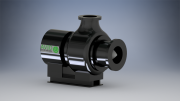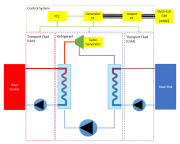The development of a new waste heat recovery system could not only deliver fuel savings of up to 8 per cent for ship owners and operators but also transform environmental standards in the marine sector
The two-year £3.6m project is funded by the Energy Technologies Institute (ETI), and is being led by AVID Technology, with the benefit of assistance from Royston Power and France’s Enogia S.A.S. North East-based engineering specialist RED Engineering is also providing support and input, as the concept, which features technology engineered to reduce emissions and vessel operating costs by converting waste heat from the vessel engine into electricity, is developed for the marine sector.

At the heart of the waste recovery system is equipment that uses the Organic Rankine Cycle (ORC) heat transfer process and a turbo generator power conversion system to convert thermal energy from the engine jacket water into electricity. Specifically, an environmentally safe refrigerant is boiled with waste heat. This refrigerant steam is then used to drive a turbine which in turn powers a generator. The refrigerant is then cooled and pumped back around the system.
This heat recovery technology is available already but what is new is AVID’s high-power density generator and electronics, which have been redesigned and packaged into a system that is much smaller in volume than traditional ORC systems.
The system is being designed to be modular in an approach that meets the demands of the retrofit market. This will allow it to be easily broken down and transported through tight hatches and access doors, although re-assembling and installing inside the vessel is bound to throw up some interesting challenges to overcome as the project moves towards completion.
The projected 8 per cent fuel saving comes from a market study completed by the ETI but multiple systems can be connected to generate more power which in turn, would generate a fuel saving that is dependent on how many systems are installed versus on-board engine power.
RED Engineering’s role is to make sure that the equipment developed complies with the appropriate marine regulations: SOLAS requirements and the class regulation of DNV GL. This involves leveraging its expertise in safety critical marine systems’ engineering and working on the documentation and design rules, which will allow the technology to progress beyond the concept to the application stage.
The firm’s engineers are also providing technical input to support the installation of a demonstration unit in 2018, while Royston is involved in working with the vessel operator to undertake installation ahead of in-vessel testing and commissioning. Enogia is responsible for the design of the ORC turbine.
The system is being developed to ensure it meets the challenge of operating in harsh marine environments on all types of vessels. There’s considerable interest being shown from cruise ship operators, where the benefits of such technologies are apparent.
However, the opportunities are wider than that sector, which does not represent the bulk of global fleets, and so the first demonstration unit will not be installed on a cruise ship. Work is therefore underway on more traditional vessels to demonstrate the potential for the technology in the mass market of marine vessels.
Progress on the project from initiation to concept phases has been rapid. Qualification testing and approval of key components is underway alongside the design and development of the turbo generator, system packaging and design approval from DNV GL.
Land-based testing of the marine specification system at full power is the next phase, which according to both RED Engineering and AVID, will herald another milestone for the programme.



